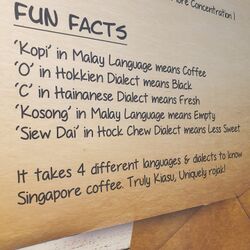Singlish

Colloquial Singaporean English, better known as Singlish, is an English-based creole language and accent spoken in Singapore. The term Singlish is a blend of Singaporean slang and English and was first recorded in the early 1970s. English is one of Singapore's official languages, along with Mandarin, Malay and Tamil. Although English is the lexifier language, Singlish has its unique slang and syntax, which are more pronounced in informal speech.
The vocabulary of Singlish consists of words originating from English, which are complemented by other Asian languages such as Malay, Cantonese, Japanese, Hokkien, Mandarin, Teochew, and Tamil. It is used in casual contexts between Singaporeans, but is avoided in formal events when certain Singlish phrases may be considered unedifying. Singapore English can be broken into two subcategories. Standard Singapore English (SSE) and Colloquial Singapore English (CSE) or Singlish as locals call it. The relationship between SSE and Singlish is viewed as a diglossia, in which SSE is restricted to be used in situations of formality where Singlish/CSE is used in most other circumstances.
Since the turn of the century, there have been recent surges in the interest of Singlish internationally, sparking several national conversations. Some of the most popular Singlish terms have been added to the Oxford English Dictionary (OED) since 2000, including wah, sabo, lepak, shiok and hawker centre. On 11 February 2015, kiasu was chosen as OED's Word of the Day. Reactions were generally positive by Singaporeans, with Singlish being commonly associated with the country and is considered a unique aspect of Singaporean culture.
It is one of two English dialects spoken in Singapore, the other being the higher variety Standard Singapore English. Singlish is used in informal contexts, where SSE is used in formal settings.
Overview
History
English in Singapore derives from 141 years of British colonialization. The received standards of English during these years were British English and Received Pronunciation. Singlish developed as a pidgin form of English, spoken by those who acquired the language without formal institutional training. Over the years, Singlish has stabilized into a creole.
Usage
Where SSE is used in formal contexts, Singlish is used in informal contexts - at home, with friends in a 'hawker centre'. Because of its lack of prestige, Singlish is generally avoided in formal contexts like meetings and interviews. However, select Singlish phrases are occasionally used to inject humour or build affinity in the audience, especially when a number of them are local.
The usage of Singlish in all contexts is strongly discouraged by the Government, who have stated that it is a 'bad' English that is incomprehensible to non-locals and stifles the proper learning and usage of English.
Some examples
- Ah - a expression to express something is already known in a sentence, stressing on something.
- Ah Mu or Ah Bu - in Hokkien is the name for Mother.
- "Aiyo/Aiya" - to express something that is not this way, also used as an exclaimation.
- AngMoh - in local Singlish or Hokkien (literally with red hair) means a westerner.
- "Blur-like-sotong" - a very confused person.
- Chapalang - literally in Hokkien means people who had eaten their fill. This is abusively used to label certain people who are likely busybodies or gossipers. The normal greeting for all Hokkien people in Singapore or those compatriots in Taiwan and Mainland China always greet one another with "have you eaten your fill? " Chapa buay"? as one would say "Good Morning" in English. The old locals are a polite people and they always say "chapa buay?"
- Chope - Singaporean slang for "reserved".
- "Chu pattern" - to describe something that is one track in nature.
- Eh - a expression to express surprise (in question mark), or used to address a context, or stressing on something (used at the end of a sentence)
- Garmen - Singaporean slang for "government".
- Good-for-nothing - a rude way of telling someone. It is used as a catch phrase to try and draw someone's attention as in Singlish.
- "hor" - used at the end of sentence to check with someone on something.
- "kiasu" - someone who has a selfish attitude due to a fear of missing out on something.
- "kiasee" - someone who is overly afraid and scared, of timid nature.
- kena - derived from a Malay word that means "to encounter or to come into physical contact", usually used negatively in context.
- lah/leh - a word filler as in Singlish.
- "liddat" - a short form of "like that", used to describe something or someones behaviour.
- "lor" - used to express something that is already known or is how it is.
- mah - a word filler as in Singlish, used at the end of sentences to describe something that is already known.
- meh - a word filler as in Singlish, used to at the end of sentences express surprise or to used to ask a question.
- one - used at the back of sentences to express effect of something. (usually used for describing scenarios or behaviour).
- "orh" - an expression to mention a point was taken or noted.
- Orh hor - used to tell someone that they should feel guilty of what they just did.
- oso - a short form of also.
- "sia/siah" - used at the end of sentence, to express emphasis of something, usually surprise and shock.
- tio - with the same meaning as kena, but can be used to express both positive and negative scenarios.
- wah - same as wow-lau, used to express surprise or shock.
- "what" - usually used as a filler to express sarcastic surprise or shock, in response to either a stupid question or nonsensical idea.